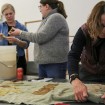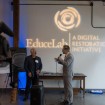John Thelin’s New Book Examines Going to College in the Sixties
John Thelin, a University Research Professor in the educational policy studies and evaluation department in the UK College of Education, has published prolifically on the history of higher education and college sports. His new book, published by Johns Hopkins University Press, is “Going to College in the Sixties.” Thelin will present at a colloquium March 5 at 5 p.m. in the Hilary J. Boone Center. A reception and book signing will follow the talk. Here, Thelin answers questions about his new book.
How long have you been at UK and why did you choose this topic?
I've been at the University of Kentucky as a professor for 22 years. And, I've been studying and writing about the history of higher education for about 45 years, starting in Graduate School at the University of California, Berkeley. I avoided this topic for a long time because it does involve personal history. Because I was a student and going to college in the ’60s. I decided that since most of the professors who went to college in the ’60s are retiring, that this was a good time. It's also the 50th anniversary of many of the landmark events and demonstrations. So, I felt there was time for historical perspective. My concern was that most of the characterizations of college in the ’60s were dramatically stilted toward student protest, unrest, demonstrations. And I think those are very important parts of the story. I also wanted to balance it with the complexity and diversity of American students and American campuses in that decade.
What was the most unexpected thing you discovered as you were sourcing material for this book?
I think it was discovering voices and groups whose stories had been untold. Paramount in that was the contributions and roles of women on campus in the 1960s. They were relatively left out. And yet, I think ultimately, they will be far and away one of the most important and significant groups. Particularly the legacy they take away after the 1960s. Because in looking at the documentary films of student groups, what I find is that women were making contributions. They were providing intellectual and political background. Yet, they were pretty much obstructed from leadership roles at co-educational campuses. At that time, there still were a number of single-gender campuses. One report came out of Princeton where the finding of the chair was "keep the damn women out." The idea that some colleges were resisting co-education. But, eventually, they came around and saw the light and transformed their admissions policies. I thought that was an important story.
Civil rights and racial exclusion were paramount. Interesting enough, is that early in the decade, some state universities were actually resistant to desegregation. And, so that you find violent student riots, for example at Ole Miss and a number of southern state universities. Student activism was actually counter to progressive change. I think that civil rights worked most effectively in the community and eventually had allies and support within the campus.
I think the students of the era were complex and contradictory. In that, within any campus, you would find splits and factions and divisions. So, one group of students was very much in a leadership role in terms of change, but coexisted with “business as usual,” with traditional student activities. So, I think you've got an interesting mix, and often it was the conflict and the tension between those groups that led to some interesting changes.
The cover of the book is a protest photo, but a lot of what you're talking about is, as you said, “business as usual”— the day-to-day operation of colleges and universities. Why was focusing not only on the protests important as you explored this topic?
One reason was in the 1960s there was a very powerful higher education leadership establishment. And they were both progressive and committed, but they also were very much in tandem, for example, with the Department of Defense, arms research, political scientists who supported the war effort. So to me, it was this coexistence and clash of cultures within the campus. That all sides had to be explained.
I think undergraduate experience, and the faculty and students who are central to that, are usually seen as sources of change and experimentation and exploration. However, if you were to look at a large complex university, such as the University of Kentucky, you would find all range of political dimensions, pursuits and activities. Even though the news will always be attracted to the most volatile events, it may miss the textures and complexities elsewhere.
What do you believe has changed for the better and what has changed for the worse about going to college between the ’60s and today?
One important change, I think, was that students gained more of a voice in terms of shaping the curriculum, serving on governing boards, having active pursuits. I think what has been lost is there was a loss of confidence in our universities in the late 1960s. I think that all groups had a fundamental belief in the efficacy and good and purposes of colleges and universities. And I think that became less certain.


